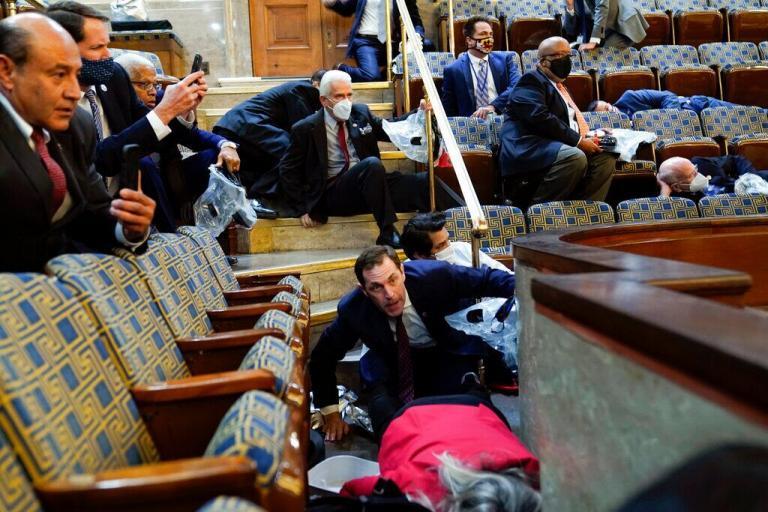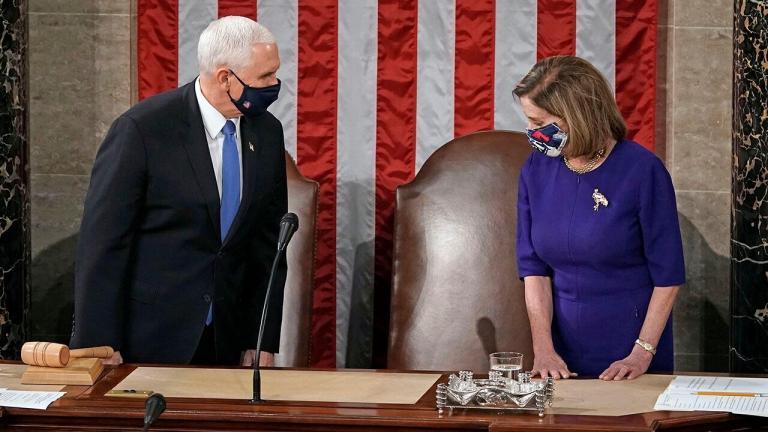The American civil bureaucracy accomplished enormous successes from the time the Constitution was adopted through the Civil War and the early years of Reconstruction. The country incorporated more than half the land mass that comprises the contiguous United States today, including through the Louisiana Purchase. The U.S. undertook and accomplished enormous public works projects, constructing the Erie Canal and the National Road, the nationwide telegram system, and the transcontinental railroad. Americans were victorious in battle, successfully repelling the British invasion in the War of 1812 and winning the Mexican-American War. These were sensational and advanced accomplishments, unrivaled among the rest of the contemporaneous world.
Today, the civil bureaucracy of that era is derided as the Jacksonian “spoils system,” which its numerous critics describe as a web of political patronage that allowed individuals to purchase positions in the federal bureaucracy with their political donations. A system as crass as that should be rightfully criticized, but the dominant “spoils system” narrative does not accurately portray the historical reality and instead merely parrots the talking points of Jackson’s political opponents to caricature a movement that actually promoted democratic accountability.
In truth, Jackson did not “gut” the federal government, as his critics allege, but replaced approximately 9 percent of its workforce with loyalists who wanted to advance the policies he had been elected to enact. This was not an affront to democracy but rather the embodiment of it, and it was not without precedent. In proportion to the size of the federal government at the time, President Jefferson gutted a larger percentage of the federal workforce when he took office, and other early presidents supported the president’s power to remove any member of the executive branch. Such removal, even at a larger scale, was not anti-democratic but a core feature of the political accountability of the executive branch.
Today, the civil bureaucracy is not creative, accomplished, or even responsive to the president; it is stagnant and a drag on the country, and it is no wonder. Rather than being staffed with regular Americans chosen for their ideas or leadership capability by a duly enacted president, the bureaucracy of today is composed of credentialed box-checkers insulated from political accountability by undemocratic civil service protections. Of the roughly 2.2 million federal bureaucrats and 10 million federal contractors, only about 4,000 roles are political appointees accountable to the president. What is worse, this unaccountable bureaucracy is an active arm of the Left, and not any reflection of the diversity of political thought among the American people or their elected leaders.
One can judge the bureaucracy by its controversies. IRS bureaucrats targeted “patriot” organizations for their conservative identity; the national security agencies wielded anti-terrorism authorities to investigate a rival presidential campaign and unmask its senior-level political advisors; bureaucrats across numerous agencies applied pressure to social media companies to repress conservative political speech with which they disagreed; and even the Department of Justice, supposedly the paragon of neutrality and the arbiter of the rule of law, has embarrassed itself over its irreconcilable enforcement choices. It executed a pre-dawn raid of Roger Stone, while allowing the statute of limitations to run on most of Hunter Biden’s crimes. It prosecuted Peter Navarro for refusing to answer a congressional subpoena, but when Eric Holder did the same, DOJ declined to bring charges. It raided, arrested, and prosecuted a pro-life protestor who was ultimately acquitted on all charges, while Antifa and BLM rioters were never charged.
Unsurprisingly, a leftist bureaucracy willing to wage war on its political opponents is also unwilling to help them achieve their policy priorities. Today, the key challenge facing a Republican president, in the words of political scientist Clinton Rossiter, is “not to persuade Congress to support a policy dear to his political heart, but to persuade the pertinent bureau or agency—even when headed by men of his own choosing—to follow his direction faithfully and transform the shadow of the policy into the substance of the program.” The reason? Federal civil service laws that protect and insulate the bureaucracy from the president’s control, contrary to the Constitution’s demands.
Reforming those laws must be a top priority of the next Trump administration, and the centerpiece of that reform cannot be the Schedule F proposal put forward in the first Trump presidency. That idea, which would at most designate a small proportion of the bureaucracy for greater presidential removal authority and control, cannot begin to stand up against the threat of the administrative state writ large. Nor is there any reason for conservatives to be satisfied with such an incremental, technocratic, work-inside-the-system proposal. The facts are apparent to the American people that the weaponization of government has never been on fuller display. There will not be a more convincing record on which to campaign to dismantle the administrative state, nor will there be a second chance to try. If the administrative state survives unscathed and unreformed after the last ten years of abuses, the already bold bureaucrats will grow bolder and and reform will be out of reach.
Today the Left defends the civil service protections of the federal bureaucracy as if they were handed down on stone tablets, but the reality is that they are an amalgamation of entrenched policies reflecting a progressive worldview, essentially a one-way ratchet that has grown more powerful with every Democrat administration and rarely if ever knocked back when Republicans ascend to power.
The first major attempt at establishing protected status for the civil service was the adoption of the Pendleton Act in 1883. In the years before its passage, the concept of civil service reform was hotly contested and a source of division in electoral politics. Public opinion for the reform coalesced in the aftermath of President James Garfield’s assassination. Garfield was shot and killed by a man named Charles Guiteau, whose professed motivation was having been passed over for a diplomatic position to which he believed he was entitled based on his support for Garfield’s campaign. In reality, Guiteau was mentally ill. He had a history of fraud and dishonest dealings as a lawyer, including pocketing money his clients won in litigation. He was a plagiarist, narcissist, thief, domestic abuser, and a self-professed prophet of God. The idea that Guiteau had any claim to a diplomatic role in the Garfield administration was merely a symptom of his insanity.
Civil service reformers relied on the emotional pull of the Guiteau story to rally support for their cause. The National Civil Service Reform League circulated nationwide a letter relying on “the recent murderous attack” to promote reform legislation. Senator George Pendleton of Ohio was even more explicit when promoting the reform bill that bore his name: Guiteau’s “desire for office—the belief that he had earned it…made this crime possible…made it possible for the assassin to assert that he thought he was doing his party and his country a service.” In fact, what made Guiteau’s crime possible was his insanity, which was surely no basis on which to enact political reform. But rhetoric like this worked, and the Pendleton Civil Service Act was enacted in 1883.
Despite the swelling support for reform based on the despicable acts of a madman, the Pendleton Act’s actual effect was modest. It charged the Civil Service Commission to institute “open, competitive examinations for testing the fitness of applicants for the public service,” examinations that would “relate to those matters which will fairly test the relative capacity and fitness of the persons examined to discharge the[ir] duties.” Jobs were to be available only to the highest-scoring applicants and also apportioned among the states and territories based on the latest census. New appointees were to be given a period of probation at the outset of their employment.
Perhaps most importantly, this new opportunity for open, merit-based civil-service selection was limited to roughly 10 percent of the federal bureaucracy at the time, essentially customs officials (“clerks and persons employed by the collector, naval officer, surveyor, and appraisers”) and some postal employees. Both categories encompassed positions of trust where political accountability was of little importance. It was important that the individuals inspecting citizens’ goods, assessing customs dues, and handling official mail be competitively selected in open, merit-based hiring, not based on political connections.
Over time, the Pendleton Act’s modest reforms have metastasized across the federal government, transforming it beyond what even its proponents would recognize.
First, the act’s coverage expanded until, roughly a century after the Pendleton Act took effect, 90 percent of the federal bureaucracy fell under the purview of the Civil Service Commission. This meant that civil service reforms that were once limited to select trust positions far removed from policymaking are today so expansive that they encompass legions of supposedly non-political civil service employees who actually perform policymaking and policy-advocating work.
The greater reach of these reforms is compounded by the enormously expanded reach of the federal government over the same period of time, a longstanding trend but one that grew exponentially out of the New Deal. Because of the ever-expanding federal government, more civil servants doing policy-related work are protected by civil service rules and the policy work they do reaches further into citizens’ lives than ever before. Protected bureaucrats can designate a neighborhood parcel as a protected wetland, eliminate incandescent lightbulbs in homes, and demand that half of cars sold be electric vehicles, infrastructure inadequacies be damned.
Second, the Carter administration scrapped merit-based examinations, which had been a key feature of civil service hiring beginning with the Pendleton Act. At the start of the Carter administration, the Professional and Administrative Career Examination (PACE) served as a gateway for college graduates seeking top agency positions in the executive branch. The test was a general intelligence exam aimed at assessing and predicting skills in verbal comprehension, judgment, and deductive, inductive, and quantitative reasoning. Studies showed that success on the test was an excellent predictor of success on the job. In the late 1970s, however, other studies emerged that indicated black test-takers performed disproportionately worse on PACE. The data was imperfect, and the Office of Personnel Management believed that the disparate test results had no “bottom line” adverse impact on minorities in PACE occupations because of other equalizing means for entering those jobs, including internal promotion. OPM data showed that 17 percent of the employees in the most populous PACE occupations were minorities, which was higher than the relevant labor market statistics at the time. But activists sued the Carter Administration over the disparate impact of PACE, and in the twilight of his presidency, Carter’s Department of Justice (perhaps without directly consulting the president or his advisors) settled the case with a consent decree that scrapped the test just as the plaintiffs sought and set in place a racial quota system instead: minority applicants must be selected for jobs at a rate proportional to the number who apply.
Various other aspects of the Pendleton Act’s reforms have been abandoned, too. There are no geographic requirements for apportioning civil service roles. Instead, the bureaucracy is primarily staffed by individuals who spend their careers in and around the District of Columbia. Far from requiring probation periods for new employees to demonstrate their fitness for their roles, in today’s civil service misbehavior is extremely difficult to address and firing nearly impossible. Unable to address misbehavior, the civil service now incentivizes performance with pay bonuses. This has not solved the problem. Even the bureaucracy’s worst performers (for example, the Veterans Administration executives who encouraged false reporting about waiting lists for hospital admissions) receive “outstanding” ratings and qualify for these incentives. The Government Accountability Office has acknowledged that the bureaucracy has no way to stratify employees based on the existing performance evaluation system, under which more than 99 percent of federal employees rate as “successful” or above. The result is that pay raises have become automatic and so-called “incentive pay” serves as “free money” to recipients, untethered from exemplary, metric-tested accomplishments.
Other reforms have also contributed to changing the character of the federal bureaucracy. John F. Kennedy gave federal employees the right to unionize and collectively bargain in 1962, and Lyndon B. Johnson expanded the right to include binding arbitration of certain disputes beginning in 1969. Every subsequent Democratic president took executive action to further expand the rights of public employee unions. President Carter enjoyed congressional support for additional pro-public-union reforms that were rolled into the Civil Service Reform Act of 1978. Among other things, that law expressed Congress’s view that public-employee unions “safeguard the public interest” because they promote “the highest standards of employee performance and the continued … implementation of modern and progressive work practices to … improve employee performance and the efficient accomplishment of the operations of the Government.” Nothing could be further from the truth today, when public-employee unions insulate low-performing or outright misbehaving federal employees from termination. Federal public employee unions impose greater costs on taxpayers and interpose quintessentially private interests (the preferences of public employees) between the citizenry and their government.
Not content merely with bargaining rights, Democrats also enacted employment protections for the civil service in the same 1978 Act. These reforms imposed for-cause limitations on subjecting covered employees to adverse employment actions and also guaranteed civil service bureaucrats extensive procedural protections before an adverse action is taken. Adverse actions include not only suspension and termination but also a reduction in grade or pay. The procedural protections include advanced notice of any adverse action, an opportunity to respond, the right to be represented, and an appeal, to be heard by the new Merit Service Protection Board, which the 1978 Act also created. These are exactly the kinds of procedural protections that a private sector union might be expected to bargain for; public employees of the federal government, however, enjoy these protections by statute, outside of any collective bargaining.
The net result of these changes is that our federal bureaucracy reflects neither the ideals of the Founders nor the principles that supposedly justified the growth of the administrative state and accompanying civil service “reform” over the past 150 years.
The Founders believed in accountable government and rejected proposals that would have insulated executive branch officers, even minor officers, from the president’s sole control. In 1789, the early Congress debated a bill to create a foreign affairs department, including what removal authority should govern it: removal by the President, or authority based in Congress, or blended between the branches? In debating the bill, Madison spoke about the Constitution’s intentions for accountability at all levels of the executive branch and the best protections against maladministration:
The danger to liberty, the danger of mal-administration has not yet been found to lay so much in the facility of introducing improper persons into office, as in the difficulty of displacing those who are unworthy of the public trust. If it is said that an officer once appointed shall not be displaced without the formality required by impeachment, I shall be glad to know what security we have for the faithful administration of the government. Every individual in the long chain which extends from the highest to the lowest link of the executive magistracy, would find a security in his situation which would relax his fidelity and promptitude in the discharge of his duty.
And he minced no words about where the chain of executive authority should terminate:
If the president should possess alone the power of removal from office, those who are employed in the execution of the law will be in their proper situation, and the chain of dependence be preserved; the lowest officers, the middle grade, and the highest, will depend, as they ought, on the president, and the president on the community. The chain of dependence therefore terminates in the supreme body, namely, in the people, who will possess besides, in aid of their original power, the decisive engine of impeachment.
In his speech, Madison explains that this structure of executive accountability flows from the Constitution itself, its structure and its guarantee of republican government.
Proponents of the burgeoning and protected civil service bureaucracy claim that the structure of the administrative state today serves other goals, goals the Founders could not have envisioned based on the size of the nation and the complexity of today’s economy. They say the demands of modern governance require rule by experts, best achieved through meritocratic bureaucracy. I have previously written about a key originator of these ideas, James Landis, an intellectual whose idea of a three-branches-in-one administrative state provided the theoretical architecture supporting FDR’s radical reconstructions and expansion of the federal government.
The drive to produce a federal bureaucracy of merited experts has been shared by both parties, such that even efforts to “reform” the administrative state have been undertaken with the goal of encouraging merit and expertise. But if the goal of the federal bureaucracy is merit, we do not have a system designed to produce it. Objective criteria, like civil service examinations, have been jettisoned. Employee performance evaluations are inflated and meaningless. Procedural protections insulate federal employees from consequences for poor performance or misbehavior.
Far from producing a meritocratic bureaucracy, the civil service system produces a bloated and lethargic class of unaccountable “experts,” who have been captured by the political Left. In the 2020 election, of those federal employees who donated to a candidate for president, most donated to Biden. In some agencies, the numbers were overwhelming: 91 percent of total dollars donated by Labor Department bureaucrats went to Biden, 85 percent at the Justice Department, and 84 percent at both the Education Department and State Department. It is no surprise, then, that when federal bureaucrats do muster themselves to get something done, it will be a priority of the Left: requiring religious organizations to provide health insurance for abortions and abortifacient drugs; imposing and enforcing vaccine mandates; enacting rules to allow retirement plans to invest based on environmental and social governance; or investigating the tax status of conservative organizations and churches.
It is impossible to understand the Trump presidency, what it accomplished and what it failed to accomplish, without understanding these attributes of the federal bureaucracy. The President no longer controls the executive branch. He can hire and fire Cabinet heads and some senior positions in each agency, but actually advancing substantive policiesrequires the participation of bureaucrats who may be happy to act when a Democrat president proposes a reform they support but who are equally happy to sabotage conservative policies through apathy, delay, or open opposition.
In my own experience, executive policy priorities originating from the White House and directed by the president were thwarted by bureaucrats across the federal government who simply refused to provide requested data (“Yes, we keep that data, but no, you can’t see it.”), or threw up flimsy procedural roadblocks (“If you want that information, you’ll have to ask someone else first.”), or dragged their feet for so long that the clock ran out (“Yes, we know we’ve already received two extensions, but we really do need more time”). And that does not account for the ways in which the bureaucracy itself stands as a gatekeeper to policy-making ideas.
In our leviathan federal government, it is impossible to monitor what the government is currently doing without a guide through the system. The only people who know, though, are bureaucrats themselves, little motivated to give an accurate accounting of their operations, thereby making it difficult or impossible to understand what problems exist and devise policies to solve them. The Trump presidency exposed these problems more than any previous administration had because the bureaucracy had never hated a president as much as it hated him.
After battling administrative state intransigence and sometimes outright revolt for nearly four years, President Trump was well aware that something had to give. In October 2020, he issued an executive order often referred to now as simply “Schedule F.” Schedule F required agencies to designate which of their employees were “in positions of a confidential, policy-determining, policy-making, or policy-advocating character.” These employees would then be placed on Schedule F (Schedules A through E already existed), and because the order’s language mirrored the 1978 Act exemption for some federal jobs, Schedule F employees would lose procedural protections against adverse employment actions that originated in the 1978 Act.
The idea was smart and its objective good. But Schedule F will not solve the problems embedded in the modern administrative state, and it cannot be the “centerpiece” of a Republican presidential administration’s deep state reforms. It would be like making the cranberry salad the star of Thanksgiving Dinner; even if it’s good, it’s not the main event.
First, Schedule F looks good on paper but is virtually impossible to actuate because it asks the agencies to determine which employees should be added to it. Agency leaders do not want this reform because they do not want to lose the procedural protections that they and their colleagues enjoy. This was on display in the immediate response to Schedule F. Although only a short time remained in the Trump administration (more on that in a moment), no agency placed positions into Schedule F before President Biden revoked it. Only the Office of Management and Budget and the U.S. International Boundary and Water Commission took the preliminary steps necessary to designate positions and would have placed 415 and 5 employees, respectively, on Schedule F. Just 13 other agencies bothered to respond at all, seven to say they needed more time to finalize their analysis, and six to say that they would not be adding any positions to Schedule F.
This exposes some of the problems I’ve already described: If your reform of the federal bureaucracy must be carried out by the federal bureaucracy, then you can be sure that the reform will fail. This is especially true of Schedule F because the determination it asks employees to make (essentially, does a given position make or advocate policy or not) is itself a political question that depends on one’s views of bureaucratic expertise. When officials at the Center for Disease Control recommended COVID responses like lockdowns and masking, were they merely stating expert views on the issues or were they making policy? When Anthony Fauci helped hand out funding for gain-of-function research in the Wuhan Labs, was he making policy or merely stating expert views on meritorious research projects? The answers to these questions likely depend on one’s political views on a variety of topics, including the proper role of government and the fallibility of experts. The Left will say that these bureaucrats are simply charged with “following the Science.”
Second, even if it were possible to fill Schedule F with a meaningfully honest list of policymaking and policy-advocating employees across all agencies, the reform would only address one part of one problem with the administrative state, the inability to take an adverse action against Schedule F employees. It would not recommit the federal government to merit-based hiring through civil service examinations; it would not shrink the bureaucracy or its reach; it would not place the bureaucracy under the president’s direct control or restore the Constitution’s balance of powers. Even the modest reform it does offer—the ability to take adverse action against the small number of newly-designated Schedule F employees more easily, up to and including termination—would be difficult to do in large numbers if an administration were so inclined. For example, the Trump administration never filled all of the political positions it was entitled to fill without the advice and consent of the Senate, sometimes leaving nearly 2,000 such positions open at once.
Third, Schedule F is not durable. Being created by executive order generally means it can be undone by executive order, and a Democrat president would surely do so (as Biden did). So if a future Trump administration spent years coercing agencies to finally designate Schedule F positions, the effort could be wasted just two years later. Plus, by announcing the reform in what turned out to be the waning days of the Trump administration, Republicans laid their cards on the table, and Democrats memorized them. A future administration should expect legal challenges to Schedule F reforms. Even if unsuccessful, such challenges would mire Schedule F in litigation for years, making it difficult to realize the reforms it promises within the span of a four-year term.
Fourth, it is also worth asking what the reform is that Schedule F actually promises. Schedule F has often been justified by its leading proponents as a way to ensure that deadbeat, no-show federal employees can finally be fired, a type of house-cleaning that even federal bureaucrats will acknowledge is necessary. If Schedule F is just cleaning up these dumpster fires, it is good but very modest indeed. If instead, the purpose is to inventory the vast network of policymaking bureaucrats operating free of chief executive control and then delete those positions en masse, the measure could go some way toward shrinking the bureaucracy and could be harder for Democrats to undo. But an action of such consequence would not be likely to succeed without my next point.
Fifth, Schedule F is a technocratic proposal. Solving for the problems of the administrative state requires more than tinkering within the system. The administrative state presents a crisis of self-governance, an attack on the Constitution itself because it betrays some of our nation’s founding principles (separation of powers, checks and balances, a republican form of government). A problem of this magnitude cannot be solved without congressional action, which cannot happen without the buy-in of the American people who must want it. And to want it, they must understand it. Otherwise, the stories will write themselves: TRUMP PUTS EMPLOYEES ON LIST JUST TO FIRE THEM; THEIR CHILDREN STARVE.
If Schedule F is an executive-only sneak attack on the administrative state, then it will be too sneaky to succeed. Big reforms require laying the groundwork that allows the public to follow along. Americans will support big reforms if they know why big reforms are needed, but they will not know if no one tells them.
Some Republicans are doing this, to their credit, and with so much fodder provided by the bureaucracy in recent memory they have plenty of rhetorical ammunition. J.D. Vance and Vivek Ramaswamy have spoken often about the administrative state as the “deep state.” Due in no small part to their influence, a generation of young Republicans are coming to see administrative state reform as the central issue of the time. Vance has said, “We have a major problem here with administrators and bureaucrats in the government who don’t respond to the elected branches. If those people aren’t following the rules, then, of course, you’ve got to fire them, and, of course, the president has to be able to run the government as he thinks he should.” Ramaswamy has described his “dream,” “that the people who we elect to run the government ought to be the ones who actually run the government. Not the managerial bureaucracy in three letter government agencies.” Yes and yes.
I understand and applaud the originators of Schedule F who thought of a way to use the president’s existing power to try to make a dent in the administrative state. The idea is creative, and I wish it had not been debuted at such an inopportune time, when its potential could not be realized and the element of surprise was lost. I am skeptical whether it can be resuscitated for a second attempt.
More importantly, I know that Schedule F is not and cannot be the silver bullet reform that Republicans advance in a second Trump administration. Schedule F is not a solution to the administrative state, and it stands a strong likelihood of becoming a major distraction to achieving more meaningful reforms. Setting Republican sights on Schedule F is like going to the Grand Canyon to see the view from the parking lot. If Republicans focus on Schedule F, Americans will miss the bigger picture, and will also miss their one, best shot at groundswell support for meaningfully diminishing the administrative state.
Now is not the time to tinker with a technical change, moving employees around on lists that are supposed to carry bureaucratic significance. Now is the time to dismantle the administrative state. Shutter an agency (or many); eliminate public employee unions; repeal civil service protections that insulate bureaucrats from presidential control.
And just downsize. In his recent piece for Tablet magazine titled “Twilight of the Wonks,” Walter Russell Mead describes how “bureaucracy is, from an information point of view, a primitive, costly, and slow method of applying algorithms (rules and regulations) to large masses of data.” With improvements in artificial intelligence and machine learning, Mead predicts that “drastic reductions in the size of both public and private sector bureaucracies will be coming.” If, as the Left says, bureaucrats are opinionless automatons just pushing paper, administering benefit formulas, or keeping planes in the sky, then every effort should be made to replace them with computers and technology that will do the job faster and cheaper.
The administrative state presents the single greatest crisis facing our county, a crisis of constitutional magnitude. The Left agrees that a crisis exists but believes the problem is the proposal to reform at all. The Left’s reaction to a change as modest as Schedule F is pearl-clutching and “destroying democracy” talk, because even a minor change threatens their citadel of power within the executive branch. That’s not a reason to pull back, it is a reason to push harder.
The idea that 2.2 million unaccountable, unelected bureaucrats should decide for themselves how best to execute the laws is an affront to our Constitutional order and to the millions of Americans who are subjected to their anti-democratic bureaucratic tyranny. This is a moment for bigger changes. If not now, when? If not Trump, then who?
Originally found on American Conservative. Read More







